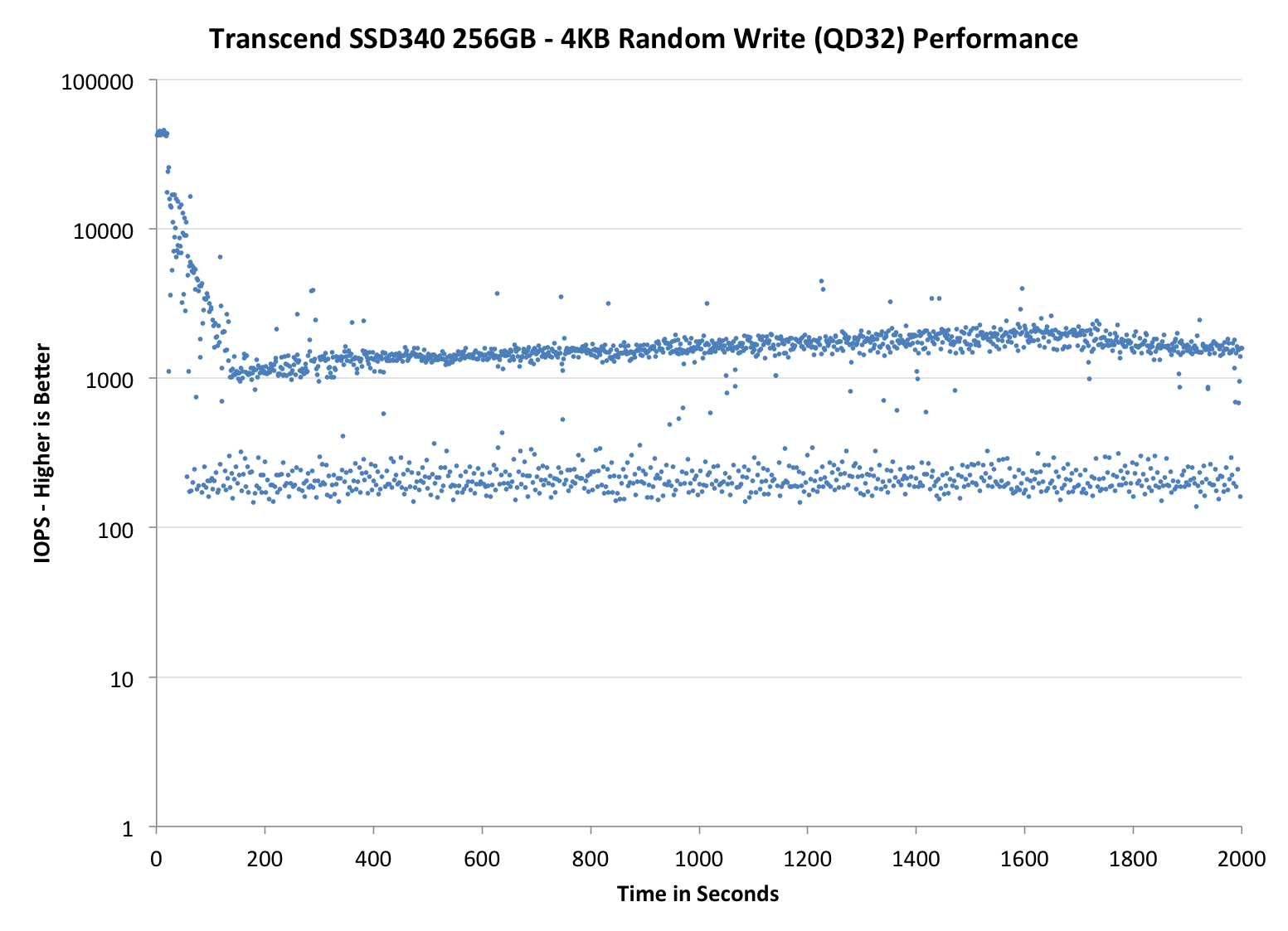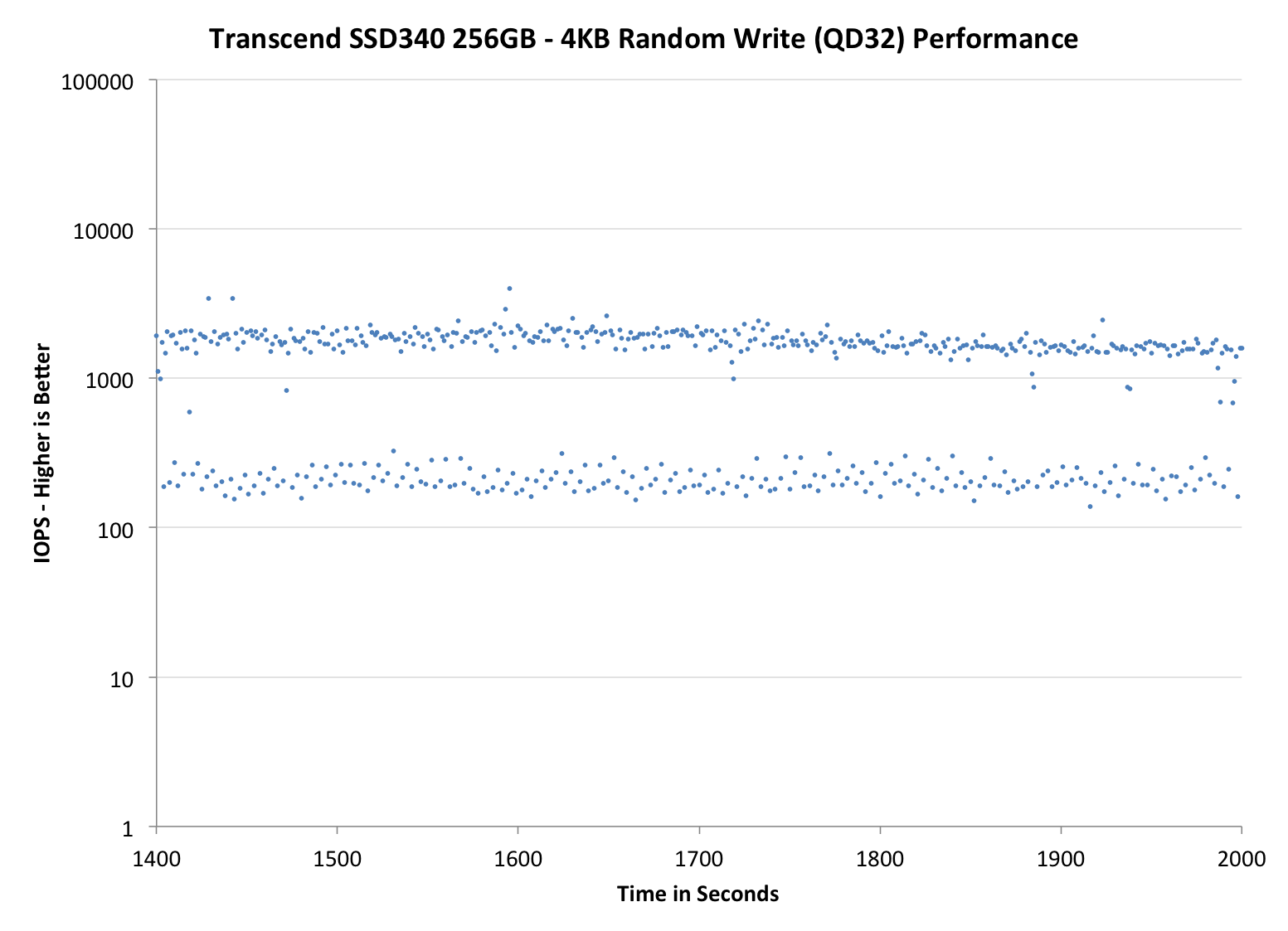Transcend SSD340 (256GB) Review
by Kristian Vättö on August 4, 2014 5:00 AM ESTPerformance Consistency
Performance consistency tells us a lot about the architecture of these SSDs and how they handle internal defragmentation. The reason we do not have consistent IO latency with SSDs is because inevitably all controllers have to do some amount of defragmentation or garbage collection in order to continue operating at high speeds. When and how an SSD decides to run its defrag or cleanup routines directly impacts the user experience as inconsistent performance results in application slowdowns.
To test IO consistency, we fill a secure erased SSD with sequential data to ensure that all user accessible LBAs have data associated with them. Next we kick off a 4KB random write workload across all LBAs at a queue depth of 32 using incompressible data. The test is run for just over half an hour and we record instantaneous IOPS every second.
We are also testing drives with added over-provisioning by limiting the LBA range. This gives us a look into the drive’s behavior with varying levels of empty space, which is frankly a more realistic approach for client workloads.
Each of the three graphs has its own purpose. The first one is of the whole duration of the test in log scale. The second and third one zoom into the beginning of steady-state operation (t=1400s) but on different scales: the second one uses log scale for easy comparison whereas the third one uses linear scale for better visualization of differences between drives. Click the buttons below each graph to switch the source data.
For more detailed description of the test and why performance consistency matters, read our original Intel SSD DC S3700 article.
 |
|||||||||
| Transcend SSD340 | JMicron JMF667H (Toshiba NAND) | JMicron JMF667H (IMFT NAND) | Samsung SSD 840 EVO mSATA | Crucial MX100 | |||||
| Default | |||||||||
| 25% OP | |||||||||
Right from the start, things do not look too promising. Compared to the reference design with the same IMFT NAND, the IO consistency is considerably lower. The reference design manages around 1,000 IOPS minimum, whereas in the SSD340 the minimum performance is around 300 IOPS. Increasing the over-provisioning helps by a bit but the consistency is still poor compared to the other value drives (like the MX100). The older firmware definitely isn't doing Transcend any favors here – quite the opposite in fact.
 |
|||||||||
| Transcend SSD340 | JMicron JMF667H (Toshiba NAND) | JMicron JMF667H (IMFT NAND) | Samsung SSD 840 EVO mSATA | Crucial MX100 | |||||
| Default | |||||||||
| 25% OP | |||||||||
 |
|||||||||
| Transcend SSD340 | JMicron JMF667H (Toshiba NAND) | JMicron JMF667H (IMFT NAND) | Samsung SSD 840 EVO mSATA | Crucial MX100 | |||||
| Default | |||||||||
| 25% OP | |||||||||
TRIM Validation
To test TRIM, I first filled all user-accessible LBAs with sequential data and continued with torturing the drive with 4KB random writes (100% LBA, QD=32) for 30 minutes. After the torture I TRIM'ed the drive (quick format in Windows 7/8) and ran HD Tach to make sure TRIM is functional.
And it is.











57 Comments
View All Comments
farhadd - Wednesday, August 6, 2014 - link
Newegg recently had the 840 EVO 1TB on sale for $390. So hopefully you'll be seeing that $250 price point by 2016.Tetracycloide - Monday, August 4, 2014 - link
Getting a SSD just because it makes less noise is not going to be a cost effective way to reduce noise for the foreseeable future. Just throw some acoustic foam in the case and use the cheapest gig/$ HDD you can find.Strunf - Monday, August 4, 2014 - link
Just put some RAM on the HTPC and set the torrent client to use a fair amount of it and minimize disk access, SSD for HTPC or torrenting is an overkill... the only real advantage of the SSD is to boot faster anything else wont really benefit from it.Zolcos - Monday, August 4, 2014 - link
Storing all your movies on the HTPC isn't practical imo, at least once you get a sizable collection. HTPCs have high requirements for noise and physical size (great place for SSD) whereas mass storage is all about cost, density, and possibly redundancy (better for HDD). You're better off building a separate file server in another room and having your HTPC play the movies off a network share. A nice big cheap raid set of HDDs will provide enough throughput to saturate your internet upload via torrenting while also having smooth 1080p playback over the LAN.tuxRoller - Monday, August 4, 2014 - link
As others have said you don't need a big ssd to meet your reqs. On Linux you could employ bcache with a small ssd (say, 32gb), and then get a big, slow saucer for bulk.I'd imagine windows offers something similar.
Samus - Monday, August 4, 2014 - link
You should really look at an SSHD for a media center. It won't cache playback of random media files, but it the 7200RPM drives have a sustained read of 150MB/sec and write of 120MB/sec at the outer sector, and the real benefit in an HTPC comes from caching startup/system data and program files. The overall response is very snappy, even SSD like.My 2.5" 1TB and 3.5" 2TB have both been excellent. Among the only Seagate products I've been happy with lately.
TonyCL6 - Thursday, August 7, 2014 - link
Seems like Transcend finally provides the new firmware? http://www.transcendusa.com/Support/No-502ddriver - Monday, August 4, 2014 - link
Too slow on sequential writes, even at its fastest it is as slow as SSDs 2-3 years ago. And 37 mb/sec? What is that? SD cards are faster...MrSpadge - Monday, August 4, 2014 - link
Using the cheaper 128 GBit NAND chips means you can only use 2 of them in parallel for 32 GB capacity.hojnikb - Monday, August 4, 2014 - link
i don' think any value 32GB sd card tops 37MB/s WRITE.And random write it will destroy pretty much every sd card you can throw at it.